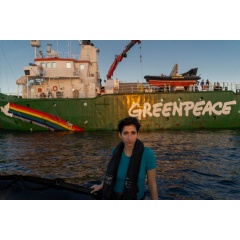Pictures: Money Heist star Alba Flores joins Greenpeace Galápagos expedition – urges governments to ratify UN Ocean Treaty and protect the High Seas
Money Heist star Alba Flores joined the Greenpeace ship Arctic Sunrise in the Galápagos Marine Reserve, to witness the beauty and the threats facing the Galápagos. She is urging governments to accelerate the UN Ocean Treaty ratification process. One year after the Treaty was agreed, it has only been ratified by Chile and Palau. To enter into force, at least 60 governments must sign the Treaty into law.[1]
Together with scientists onboard, Flores observed first hand the species abundance and diversity above and on seamounts inside and outside of the Galápagos Marine Reserve, which is one of the best examples of ocean protection in action.[2] Yet, just outside the reserve, vast industrial fishing fleets continue to devastate marine life. What happens just outside the reserve has direct negative impacts inside, and this place has no protection from these impacts.
Alba Flores, best-known for playing Nairobi in the hit Netflix series Money Heist, said: “The UN agreeing the Ocean Treaty was a historic moment that filled with hope for the future. In the Galápagos I have experienced the powerful beauty of nature but I know that close by, there are threats to the health of the archipelago, especially in the high seas areas outside the Galápagos Marine Reserve.
“Before the Ocean Treaty was agreed, it was impossible to protect this high seas area. But now governments have a chance to use the Treaty to boost protection of the Galápagos and provide a powerful example to the rest of the world of how to protect the high seas. We only need political will to make it happen. I hope my presence onboard will push more people to mobilise and to support the ratification of the treaty by their own governments. I am just one voice among many other voices, people have the power with our voices and other tools to help protect the oceans.”
Laura Meller, from Greenpeace’s Protect the Oceans campaign, said: “A new high seas protected area, complementing the Galápagos Marine reserve, would benefit the astonishing wildlife as well as local fishers from the neighbouring countries. This new protected area could be closed to industrial international fleets, boosting fish populations and increasing catches for fishers who operate close by in the waters of neighbouring countries. The UN Ocean Treaty will give us a tool to deliver this protection, if it is urgently ratified by at least 60 countries.”
All over the world the high seas are home to millions of species and ecosystems, but less than 1% are fully protected. They are under increasing pressure from a range of threats, including industrial fishing, pollution and the emerging deep sea mining industry. To protect 30% of the oceans by 2030, we must protect more than 11 million km² of ocean every year.[3]
In late March, the Arctic Sunrise will continue on to Colombia to promote the conservation of the Colombian tropical Pacific.
Pictures and footage of Alba Flores on the Arctic Sunrise available in the Greenpeace Media Library.
Notes to editors
Along with scientists from the Jocotoco Conservation Foundation, the Charles Darwin Foundation, the Galapagos Science Center and MigraMar, and park rangers from the Galápagos National Park, Greenpeace’s expedition will emphasise the power of marine protection, documenting the success of the Galápagos Marine Reserve and the incredible wildlife and habitats of the sea near the Galápagos. Data collected during the expedition will strengthen the case for a new high seas protected area.
Laura Meller is Ocean Policy Advisor with Greenpeace Nordic, working in Greenpeace’s Protect the Oceans campaign.
[1] Signing the Treaty shows an “intent to ratify”. Ratification requires domestic legislation, and would sign the Treaty into law. The Treaty will become a legally binding instrument once at least 60 countries pass the necessary domestic legislation to ratify the Treaty and formally deposit their ratification at the United Nations. Greenpeace UK created an interactive map where ratification of the treaty can be monitored, along with threats on the oceans : https://maps.greenpeace.org/maps/gpuk/30×30/
[2] There is an area of high seas east of the Galápagos Marine Reserve, surrounded on three sides by the waters of Ecuador, Colombia and Costa Rica. The area also overlaps with the Tropical East Pacific Marine Corridor (CMAR), which includes the three countries plus Panama, and together they work as an interregional body to protect and manage the biodiversity and coastal resources in this area.
[3] All governments agreed to protect at least 30% of the world’s oceans by 2030 under the Convention on Biological Diversity in 2022.
( Press Release Image: https://photos.webwire.com/prmedia/8/318906/318906-1.jpg )
WebWireID318906
This news content was configured by WebWire editorial staff. Linking is permitted.
News Release Distribution and Press Release Distribution Services Provided by WebWire.
